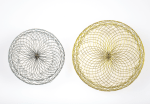Atrial fibrillation is the most prevalent arrhythmia and to prevent its potential complications, we should administer anticoagulants (OACs), either warfarin or the new direct oral anticoagulants (DOACs). Even though these drugs have been shown effective, they still involve the risk of bleeding, especially gastrointestinal bleeding, which in turn leads to numerous hospitalizations. Left atrial appendage occlusion...
Predictors and Evolution of Permanent Pacemaker After TAVR with Self-Expanding Valves
Transcatheter aortic valve replacement (TAVR) has shown remarkable benefits and continues to advance towards lower-risk patients and younger ages. However, one of its limitations lies in the demand for a permanent pacemaker (PPM), which during TAVR early stages with self-expanding valves reached 30%. Uncertainty persists regarding the evolution of patients undergoing PPM implantation after TAVR,...
Moderate Aortic Stenosis: We Should Start Assessing It More Thoroughly
Moderate aortic stenosis (MAS) encompasses a broader spectrum than severe aortic stenosis. However, its progression has not yet been fully elucidated. While there are reports suggesting that this condition is not as benign as initially believed, there is a need to consider early interventions in certain instances. Researchers conducted an analysis from January 2016 to...
Long Term Outcomes after Complex PCI According to Operator Experience and Use of IVUS
The use of intravascular ultrasound (IVUS) to guide percutaneous coronary interventions (PCI) has been shown to reduce the risk of major adverse cardiovascular events (MACE) across controlled randomized studies, registries and meta-analysis. Current guidelines recommend the use of IVUS in left main disease and complex lesions. As the prevalence of complex PCI increases over time,...
SOLACI-SBHCI 2023 Scientific Coverage – Day 3
The third day of the Congress started at the Copacabana Arena with the International Live Case held at Nanjing First Hospital, Nanjing, China, which showcased a successful and illustrative step-by-step Transcatheter Coronary Intervention (TCI) angioplasty with circulatory support and optimized results using Intravascular Ultrasound (IVUS) applicability. Following that, Dr. Fei Ye presented Intravascular Imaging and...
Crisis and Socioeconomic Disparities: Relationship with Recurrent Events After Myocardial Infarction
Socioeconomic status (SES) has been linked to recurrent atherosclerotic cardiovascular disease events (rASCVD) after myocardial infarction (MI). However, patients with low SES are underrepresented in most randomized studies. This may be largely due to a higher incidence of metabolic syndrome, insufficient use of recommended medication, such as statins, for secondary prevention and insufficient participation in...
Are There Sex Differences in pLVAD-Assisted High Risk PCI?
The proportion of patients undergoing high risk PCI (HRPCI) is on the rise. It includes patients with different clinical, anatomical and procedural characteristics, such as low ejection fraction, severe vascular disease, three vessel or left main disease, severe lesion calcification and the use of atherectomy. Mechanical circulatory support devices (MCS) during HRPCI, such as the...
SCOPE I Results at 3 Years: ACURATE Neo vs. SAPIEN 3
Transcatheter aortic valve implantation (TAVI) has become the standard treatment for elderly patients with severe symptomatic aortic stenosis. While this has led to the development of new devices with different features, evidence from randomized studies on these new scaffolds is limited. The randomized SCOPE I study (Safety and Efficacy of the Symetis ACURATE Neo/TF Compared...
STREAM-2: Reduced Dosage of Tenecteplase for Patients over 60 Years Old
Reduced dosage of tenecteplase in elderly patients undergoing a pharmaco-invasive strategy. Delays in achieving timely reperfusion in patients with acute coronary syndrome with ST elevation (STEACS), whether through fibrinolysis or primary percutaneous coronary intervention (PCI), are associated with increased mortality. European guidelines establish a target reperfusion time of 120 minutes after the first medical contact...
No Reflow after Primary PCI in STEMI: An Angiographic Analysis of the TOTAL Study
In the early days of percutaneous coronary intervention (PCI) in patients with ST elevation acute myocardial infarction (STEMI), no reflow phenomenon was known as an indicator of the worst possible outcomes in terms of left ventricular remodeling, infarct size, ejection fraction and mortality, at long term. The TOTAL study (Routine Aspiration Thrombectomy with PCI Versus...









